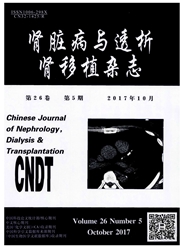

 中文摘要:
中文摘要:
目的:建立一种离心式与膜式血浆分离技术组合的新型双重血浆置换(DFPP)模式,通过前瞻、非随机对照研究与膜式DFPP比较,观察其临床治疗的有效性、安全性及优势。方法:入选因抗肾小球基膜(GBM)抗体或抗中性粒细胞胞质抗体(ANCA)介导疾病需行DFPP的患者,分为两组:已有中心静脉导管及可充分抗凝者接受膜式DFPP,其余患者接受组合式DFPP。前者采用血浆分离器MPS07分离血浆,后者采用血细胞分离机分离血浆,两组均经二级血浆成分分离器EC20W进行再处理。单次治疗处理1.5倍血浆量,每次补充35~45g人血白蛋白。结果:入选32例患者(男性15例),膜式DFPP组14例,组合式DFPP组18例。共行DFPP 79次,其中膜式DFPP 27次。膜式及组合式DFPP对Ig G、Ig A、Ig M的下降率无差别;白蛋白补充量及治疗后血清白蛋白的下降率亦无明显差别;血小板下降率两者相似(P=0.114);但膜式DFPP致病抗体的下降率显著低于组合式DFPP[(25.62%±11.67%)vs(36.78%±16.44%),P=0.043]。膜式DFPP组治疗中血流量显著高于组合式DFPP组(P〈0.001);组合式DFPP低分子肝素使用量明显少于膜式DFPP(P〈0.001);组合式DFPP没有增加分离器凝血、溶血、破膜等不良反应。结论:离心/膜分离组合式DFPP除明显技术优势包括血流量要求低、抗凝需求低外,还具有更好的致病性抗体清除效果,其对血小板的影响与传统DFPP并无差别,不良反应发生率低,具有较好的应用前景。
 英文摘要:
英文摘要:
Objective: To establish a new mode of double filtration plasmapheresis (DFPP) combining centrifugal/membranous plasma separation techniques, and to evaluate its efficacy, safety and advantages compared with the traditional membranous DFPP (M-DFPP) through a prospective, nonrandomized controlled study. Methodology: Patients requiring DFPP treatment were screened for enrollment. They received DFPP due to renal diseases associated with anti-neutrophil cytoplasmic antibody (ANCA) or anti-glomerular basement membrane (GBM) antibody. After enrollment, patients who already had central venous catheter and had no contraindications for adequate systemic anticoagulant were assigned to receive M-DFPP, and the others were assigned to receive centrifuge/membrane hybrid DFPP ( C/M-hybrid DFPP). For M-DFPP, plasma was separated by a plasma separator MPS07, and passed through a fractional plasma separator EC20W for a second filtration; while for C/M-hybrid DFPP, plasma was separated by a centrifugal apheresis system and was secondly filtrated through a EC20W filter, which was the same as in M-DFPP. For one session of DFPP, up to 1.5 fold of the total plasma volume was processed, with a supplement of 35 - 45g human albumin. Results: 32 patients ( 15 males) were divided into 14 in M-DFPP and 18 in C/M-hybrid DFPP. A total of 79 sessions of DFPP were performed,with 27 sessions of M-DFPP and 52 sessions of C/M-hybrid DFPP. There was no significant difference between M-DFPP and C/M-hybrid DFPP in the regards of reduction ratio of IgG, IgA, IgM, as well as the amount of supplemented human albumin, reduction ratio of serum albumin and platelets counts [ (9. 05%±11.89%) vs ( 17.00%±14. 91%) ,P=0. 114]. While for the reduction ratio of the titer of autoimmune antibodies, C/M-hybrid DFPP was higher than M-DFPP [ (36.78%±16.44%) vs. 25.62%±11.67%) , P=0. 043]. The blood flow rate in M-DFPP was significantly higher than that in C/M-hybrid DFPP [ (118.21±8.68) ml/min vs. (35.29±4. 14)
 同期刊论文项目
同期刊论文项目
 同项目期刊论文
同项目期刊论文
 Fluid overload at start of continuous renal replacement therapy is associated with poorer clinical c
Fluid overload at start of continuous renal replacement therapy is associated with poorer clinical c 期刊信息
期刊信息
